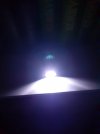My Gimbal videos suffer from being created in the moment, without fully understanding all the of the points that were eventually raised. Plus I wasn't very good at making video back then.
So I'd like to make a new one, just about the rotating glare hypothesis. Stopping short of 3D positioning the object (I'll leave that to @Edward Current for now) but recapping the various things people have pointed out that support the rotating glare hypothesis, and answering any objections. I'd like to only make it once
Here's what I have so far, terms items of evidence.
1. IR GLARE EXISTS - IR Glare exists in other videos, and can obscure the plane.
2. FLIR1 SIMILARITY - The start of FLIR has a star shaped glare, similar at point to the Gimbal glare
3. NOT ROTATING WITH BANK CHANGES - When the plane increases bank at 8 and 19 seconds, the horizon rotates with the plane, but the glare does not rotate - indicating it's fixed to the camera frame of reference, not the object. https://www.metabunk.org/threads/do...bunk-the-claim-that-the-object-rotates.12068/
4. BUMPS BEFORE ROTATION - When then object rotates at 23, 27, 28, and 32 seconds, the rotation is preceded by a camera bump, indicating the camera is affected by whatever causes the rotation, hence it's likely the camera pod itself. https://www.metabunk.org/threads/fl...aims-to-refute-micks-claims.11933/post-255387
5. ROTATING LIGHT PATTERNS - When the object rotates at 28 seconds, while the plane bank remains constant, a pattern of light across the frame (but only visible against the sky) also rotates. (Originally here, but bit visualizations done by Goddard)
6. MATCHES NEEDED TRAVERSAL ROTATION - The amount of rotation of the object, while intermittent, follows the graph of expected rotation needed for the main roll axis to traverse the gimbal singularity (i.e crossing 0° roll at a 2° pitch) https://www.metabunk.org/threads/gi...lines-of-bearing-and-or-dcs.11836/post-262598
7. The video is called "Gimbal" by the US Navy, suggesting they might think the gimbal in the camera was related to what is shown.
I'd also like to give correct credits for the development of these ideas, so would appreciate pointers to other instances, before or after the ones linked above, including on other sites.
Also, what are the main objections that need addressing? Just about the glare and the rotation - not "but they would have known if a plane was there", which is a different issue.
So I'd like to make a new one, just about the rotating glare hypothesis. Stopping short of 3D positioning the object (I'll leave that to @Edward Current for now) but recapping the various things people have pointed out that support the rotating glare hypothesis, and answering any objections. I'd like to only make it once
Here's what I have so far, terms items of evidence.
1. IR GLARE EXISTS - IR Glare exists in other videos, and can obscure the plane.
2. FLIR1 SIMILARITY - The start of FLIR has a star shaped glare, similar at point to the Gimbal glare
3. NOT ROTATING WITH BANK CHANGES - When the plane increases bank at 8 and 19 seconds, the horizon rotates with the plane, but the glare does not rotate - indicating it's fixed to the camera frame of reference, not the object. https://www.metabunk.org/threads/do...bunk-the-claim-that-the-object-rotates.12068/
4. BUMPS BEFORE ROTATION - When then object rotates at 23, 27, 28, and 32 seconds, the rotation is preceded by a camera bump, indicating the camera is affected by whatever causes the rotation, hence it's likely the camera pod itself. https://www.metabunk.org/threads/fl...aims-to-refute-micks-claims.11933/post-255387
5. ROTATING LIGHT PATTERNS - When the object rotates at 28 seconds, while the plane bank remains constant, a pattern of light across the frame (but only visible against the sky) also rotates. (Originally here, but bit visualizations done by Goddard)
6. MATCHES NEEDED TRAVERSAL ROTATION - The amount of rotation of the object, while intermittent, follows the graph of expected rotation needed for the main roll axis to traverse the gimbal singularity (i.e crossing 0° roll at a 2° pitch) https://www.metabunk.org/threads/gi...lines-of-bearing-and-or-dcs.11836/post-262598
7. The video is called "Gimbal" by the US Navy, suggesting they might think the gimbal in the camera was related to what is shown.
I'd also like to give correct credits for the development of these ideas, so would appreciate pointers to other instances, before or after the ones linked above, including on other sites.
Also, what are the main objections that need addressing? Just about the glare and the rotation - not "but they would have known if a plane was there", which is a different issue.


